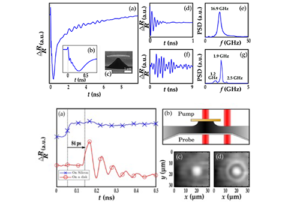Designing acoustic sources adjusted in frequency and size

Nano-objects have many properties that have led to applications in recent years, particularly in the field of optics. From the point of view of elasticity, these systems, whose size can go down to a few nanometers, were initially considered to test the limit of validity in size of the hypothesis of the mechanics of continuous media. Neverthless, very quickly the question of the coupling of these resonators with the environment emerged. Strategies were found to reduce this coupling to obtain resonators with a very high quality factor, for example by working on self-suspended 1D systems. An inverse way, was to take advantage of this coupling in order to create new adjustable acoustic sources at high frequency (>100GHz). In this context, the members of the “Acoustics for Nanosciences” team of INSP have developed a hybrid approach integrating these two aspects in order to create acoustic sources adjustable in frequency as well as in size.
Caption
Figure 1: a) and b) Time evolution of the reflectivity change of a gold disk of 3.4µm diameter and 100nm thickness. c) Geometry of the partially self-suspended nanostructure. d) and f) Extraction of the oscillating behaviors of the two contributions. e) Spectrum of thickness modes. g) Spectrum of radial modes.
Figure 2: a) Variation of the reflectivity measured on a disk. b) Geometry of the measurement. c) and d) Mapping of the emitted waves with a time interval of 60ps.
Reference
“Substrate influence on the vibrational response of gold nanoresonators: Towards tunable acoustic nanosources”
R. Delalande, J. Bonhomme, E. Dandeu, L. Becerra, L. Belliard
Phys. Rev. B 105, 035422 (2022)
laurent.belliard(at)sorbonne-universite.fr
